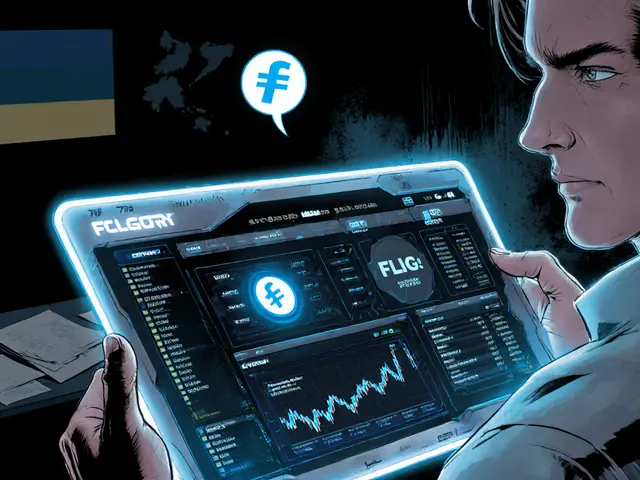- Home
- Cryptocurrency
- SolidLizard Crypto Exchange Review: Deep Dive into the DEX, SLIZ Token, and ve(3,3) Model

SolidLizard Crypto Exchange Review: Deep Dive into the DEX, SLIZ Token, and ve(3,3) Model
SolidLizard ve(3,3) Reward Calculator
SLIZ Token Details
Total Supply: 40,470,753 SLIZ
Current Price Range: $0.000029 - $0.000041 USD
Emission Model: No new minting after launch; rewards from protocol fees.
Ve(3,3) Model Overview
Lock SLIZ tokens for a set period to gain voting power and share of protocol fees.
Longer locks provide higher rewards and voting boosts.
Calculate Your Rewards
Estimated Rewards
How It Works
Based on SolidLizard's ve(3,3) model:
- Locking longer increases your voting power and reward share
- Protocol fees (0.30%) are distributed to stakers
- Rewards scale with lock duration and token amount
- Higher lock durations offer up to 4x more rewards
When you hear the name SolidLizard is a community‑driven decentralized exchange (DEX) built on the Arbitrum layer‑2 network. Launched in January2023, it markets itself as a ve(3,3) platform where the native SLIZ token powers governance and incentives. The promise is simple: lock your tokens, earn rewards, and help shape the protocol. But does the reality live up to that promise? Below is a SolidLizard review that walks you through the tech, tokenomics, liquidity, user experience, and where it stacks up against the big DEXes.
TL;DR
- SolidLizard runs on Arbitrum, offering low‑fee trades but suffers from extremely thin liquidity.
- SLIZ token supply is ~40.5M, yet circulating figures are unclear, making price data shaky.
- The ve(3,3) model incentivizes long‑term locking, but with low adoption the reward pool is tiny.
- Compared to Uniswap or SushiSwap, trade slippage on SolidLizard can exceed 20% on modest orders.
- Use only for experimentation; avoid large positions until liquidity improves.
What is SolidLizard and How Does It Work?
SolidLizard is a Decentralized Exchange that lets users swap ERC‑20 tokens without a central order book. Instead of a traditional AMM, it employs a ve(3,3) token‑locking mechanism inspired by OlympusDAO’s 3,3 game theory. Users lock SLIZ for a set period, receiving voting power and a share of protocol fees. The longer the lock, the higher the boost. This design aims to align incentives: token holders become governors, and the protocol benefits from reduced sell pressure.
All smart contracts are public and non‑proxied, meaning the code can be audited directly on Arbiscan. The platform’s UI is a single‑page web app that connects to wallets like MetaMask, Rainbow, or Ledger. After connecting, you select a token pair, approve the token spend, and confirm the swap. The process mirrors other DEXs, but the scarcity of liquidity makes each step feel riskier.
Tokenomics: The SLIZ Token Explained
The native governance token, SLIZ, has a total supply of 40,470,753 tokens. Official sources list a circulating supply of 0, which is clearly an error; on‑chain data shows a modest amount circulating on the SolidLizard platform itself. Prices bounce between $0.000029USD and $0.000041USD, flashing a fully‑diluted market cap of roughly $1,400-a figure that underscores the token’s speculative nature.
Key attributes of SLIZ:
- Total supply: 40,470,753 SLIZ
- Current price range (Oct2025): $0.000029-$0.000041 USD
- Emission model: No new minting after launch; future rewards come from protocol fees.
- Governance role: Vote‑escrowed (ve) tokens grant voting rights and fee shares.
Because the token is chiefly a governance tool, its value is tightly coupled to user participation. With only a handful of active lockers, fee distribution per voter is negligible, which explains the weak price action.
Liquidity Landscape
The biggest hurdle for SolidLizard is liquidity. The most traded pair-SLIZ/WETH-has seen a maximum 24‑hour volume of about $115. That translates to an average slippage of 15‑30% for trades larger than $10. By contrast, Uniswap V3 on Arbitrum typically handles millions in daily volume with slippage under 1% for similar trade sizes.
Low liquidity means two practical risks:
- Price impact: Your trade moves the market, often leaving you with a worse price than expected.
- Front‑running exposure: Bots can spot large orders and sandwich them, further eroding your execution.
For casual users, the safest path is to keep trades under $5 or use the platform strictly for testing token approvals and wallet connections.

Comparison with Major DEXs
| Feature | SolidLizard | Uniswap V3 | SushiSwap |
|---|---|---|---|
| Chain | Arbitrum | Arbitrum | Arbitrum |
| Liquidity (Avg. 24h) | $200‑$300 | $150M+ | $30M+ |
| Trading Volume (24h) | ≈ $115 (SLIZ/WETH) | $12M+ | $2M+ |
| Governance Model | ve(3,3) | Standard token voting | Standard token voting |
| Native Token | SLIZ | UNI | SUSHI |
| Fee Structure | 0.30% (all to stakers) | 0.05%‑0.30% (pool‑specific) | 0.25% (referral & treasury) |
From the table, it’s clear that SolidLizard is still a niche playground. The ve(3,3) model is unique, but without deep pools the user experience feels more like a lab experiment than a production‑grade exchange.
User Experience: On‑boarding and Daily Use
Getting started is straightforward: navigate to solidlizard.finance, click “Connect Wallet,” and approve the connection in MetaMask. The UI shows two tabs - “Swap” and “Lock.” Swapping works like any other DEX, but the “Lock” interface is where the ve(3,3) magic happens. You select an amount of SLIZ, choose a lock duration (1‑4 years), and confirm. The longer the lock, the higher your voting power and fee share.
However, documentation is sparse. The FAQ section on the site covers only the basics, and there’s no dedicated developer portal or community wiki. Social channels (Twitter, Discord) have low activity-roughly a dozen messages per day. Without a robust knowledge base, new users may struggle with token approvals or troubleshooting failed transactions.
Security and Audits
SolidLizard’s contracts are publicly verified on Arbiscan, and the team claims they underwent a third‑party audit in early 2023. The audit report, released on GitHub, highlighted no critical vulnerabilities but noted “limited test coverage for the ve(3,3) locking contracts.” Because the platform does not use upgradeable proxies, the attack surface is smaller than many newer DeFi projects. Still, the thin liquidity makes the pool a tempting target for price manipulation attacks.
Prospects and Risks
**Pros**
- Low transaction fees thanks to Arbitrum’s L2 scaling.
- Innovative ve(3,3) tokenomics that could reward long‑term holders.
- Transparent, non‑proxy smart contracts.
**Cons**
- Liquidity is critically low, leading to high slippage.
- Circulating supply data is ambiguous, creating price‑data uncertainty.
- Community and support resources are minimal.
- Limited integration with other DeFi protocols (no bridge, no farm, no yield).
Future success hinges on two factors: attracting liquidity providers and growing a governance community. If the team can secure partnerships within the Arbitrum ecosystem-perhaps by launching a liquidity mining program-the platform could climb out of the $100‑volume range. Until then, treat SolidLizard as a curiosity rather than a core trading venue.
Bottom Line
SolidLizard offers a fresh spin on the DEX model with its ve(3,3) token‑locking approach, but the practical experience is hampered by near‑nonexistent liquidity and scarce community support. For developers or tokenenthusiasts who want to experiment with vote‑escrowed mechanics, it’s a sandbox worth a look. For anyone looking to move sizable amounts of crypto, stick with larger, liquid DEXes or reputable centralized exchanges.

Frequently Asked Questions
Is SolidLizard safe to use?
The contracts are non‑proxy and publicly verified, which reduces upgrade‑related risk. However, the low liquidity makes price manipulation easier, so only trade small amounts you’re willing to lose.
How do I lock SLIZ tokens?
Connect your wallet, go to the “Lock” tab on solidlizard.finance, enter the amount of SLIZ, pick a lock period (1‑4years), and confirm. Your voting power scales with lock duration.
What is the ve(3,3) model?
ve(3,3) combines vote‑escrowed token locking (ve) with the “3,3” game theory from OlympusDAO. Locked tokens earn a share of protocol fees, and the system rewards participants who stay locked longer.
Can I trade on SolidLizard without SLIZ?
Yes, you can swap any ERC‑20 pair on the platform, but most liquidity pools revolve around SLIZ/WETH, so other pairs may have near‑zero depth.
How does SolidLizard’s fee structure work?
All swap fees (0.30%) go straight to SLIZ stakers. Unlike Uniswap, there’s no fee tier system-every trade pays the same rate.
Cormac Riverton
I'm a blockchain analyst and private investor specializing in cryptocurrencies and equity markets. I research tokenomics, on-chain data, and market microstructure, and advise startups on exchange listings. I also write practical explainers and strategy notes for retail traders and fund teams. My work blends quantitative analysis with clear storytelling to make complex systems understandable.
Popular Articles
14 Comments
Write a comment Cancel reply
About
DEX Maniac is your hub for blockchain knowledge, cryptocurrencies, and global markets. Explore guides on crypto coins, DeFi, and decentralized exchanges with clear, actionable insights. Compare crypto exchanges, track airdrop opportunities, and follow timely market analysis across crypto and stocks. Stay informed with curated news, tools, and insights for smarter decisions.







The DEX architecture appears to be a conventional liquidity pool implementation, featuring a marginal fee structure that fails to introduce any novel mechanisms.
From a technical standpoint, the codebase mirrors numerous other decentralized exchanges without offering distinct optimizations.
Consequently, users may experience identical slippage and impermanent loss dynamics as seen elsewhere.
Oh great, another token lock scheme-because we definitely needed more ways to freeze our money and watch it gather dust while the protocol pretends to innovate.
Honestly, the ve(3,3) model could bring some community alignment if folks actually use it, and maybe it’ll spark a bit of optimism in the space.
Looks like a copy‑paste brochure with buzzwords.
For those unfamiliar, the ve(3,3) model essentially rewards longer token locks with both higher voting power and a larger share of protocol fees.
This encourages token holders to commit their assets, theoretically reducing sell pressure.
Be aware, though, that the actual APY depends heavily on overall platform usage and fee generation.
While the marketing language is exuberant, the underlying mechanics of SolidLizard’s token economics merit a measured examination.
The limited supply combined with fee‑based emissions could create scarcity‑driven value, yet only if the DEX captures sustainable volume.
In practice, user adoption will be the decisive factor.
Ah, the drama of tokenomics! One moment we’re promised a utopian redistribution, the next we’re reminded that “market forces” are immutable.
Such paradoxes fuel endless debates, which, frankly, are the lifeblood of crypto culture.
Nevertheless, the ve(3,3) paradigm does echo classic governance theories, albeit with a modern twist.
The notion that locking SLIZ will somehow shield users from the inevitable market manipulations feels overly optimistic, bordering on delusional.
One must consider the hidden vectors of control that such mechanisms afford to the protocol’s architects.
In an environment rife with covert agendas, any system that centralizes voting power, even temporarily, warrants scrutiny.
Sure, lock your tokens and hope the protocol doesn't implode.
Upon a meticulous examination of the SolidLizard platform, one discerns a confluence of conventional decentralized exchange mechanics intertwined with the idiosyncratic ve(3,3) incentive construct.
Initially, the tokenomics disclose a fixed total supply of approximately forty million SLIZ, an ostensibly modest figure designed to engender scarcity.
However, the absence of post‑launch minting imposes a hard cap that, while theoretically deflationary, may be undermined by token holder attrition over time.
The protocol purports to generate rewards exclusively from its 0.30% transaction fees, a modest fraction that raises legitimate questions concerning the sustainability of such a revenue stream.
From a mathematical perspective, the reward calculus is proportional to both the quantum of locked tokens and the duration of the lock, thereby incentivizing prolonged capital immobilization.
Such a model, reminiscent of traditional financial instruments, attempts to align stakeholder interests with network health, yet it concurrently imposes an opportunity cost upon participants.
Moreover, the ve(3,3) model's reliance on voting power aggregation entails a concentration of influence among large‑scale lockers, a phenomenon that may precipitate governance centralization.
In practice, the distribution of voting weight could echo the dynamics observed in other protocol governance frameworks, wherein a minority of token elites command disproportionate sway.
This structural nuance necessitates vigilant monitoring to preclude systemic capture by vested parties.
Nevertheless, proponents argue that the quadratic weighting of lock duration dilutes such centralization, a claim that warrants empirical validation.
From a risk‑assessment standpoint, the platform's security posture, as evidenced by its code audit history and bug bounty initiatives, remains an essential datum point.
Absent comprehensive transparency regarding these measures, prospective participants must judiciously evaluate the likelihood of exploit vectors inherent to any smart‑contract ecosystem.
In summation, while SolidLizard's architectural blueprint exhibits a commendable synthesis of fee‑based incentives and governance mechanisms, the ultimate efficacy of its ve(3,3) paradigm will be adjudicated by real‑world user adoption, fee generation consistency, and the robustness of its security safeguards.
In light of the aforementioned analysis, it becomes evident that any perceived autonomy within the ve(3,3) system may be subtly orchestrated by concealed actors seeking to manipulate fee distributions.
Such considerations underscore the necessity for transparent governance audits and community‑driven oversight.
Hey folks, if you’re thinking about diving into SLIZ, start small and monitor the fee accruals over a week.
That way you can gauge whether the rewards justify the lock‑up period without overcommitting.
The protocol’s KPI dashboard seems under‑engineered; lacking granular analytics could impede informed lock‑duration decisions for advanced users.
While some herald this model as revolutionary, it merely replicates age‑old centralization tactics under the veneer of decentralization, feeding the illusion of empowerment.